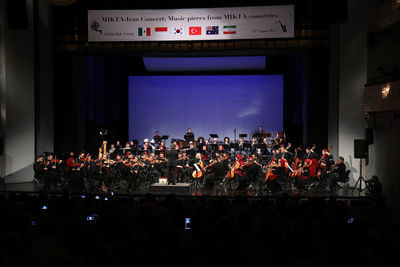Tehran’s Vahdat Hall last night played host to the Tehran Symphony Orchestra, which performed a colorful range of classical compositions from Iran and the MIKTA countries (Mexico, Indonesia, Korea, Turkey and Australia) under the baton of Iranian maestro Shahrdad Rohani.
The performance, organized by the MIKTA countries embassies in Tehran, was as much a diplomatic effort as it was a move for enhancing cultural ties between Iran and MIKTA – an informal consultation and coordination platform among Mexico, Indonesia, Korea, Turkey and Australia formed in 2013 on the margins of the 68th UN General Assembly.
Before the concert, ambassadors and chargé d'affaires of MIKTA countries present at the event, took to the stage to welcome the audience and highlight their respective countries’ efforts to share their cultures with Iran in a bid to further develop friendly relations.
The music director and principal conductor of the event, maestro Shahrdad Rohani, voiced happiness over the opportunity of conducting this “important political and artistic event”, and began the performance with two pieces from Turkey: “Rondo Alla Turca”, also known as the Turkish March, which is the last movement of Mozart’s Sonata No. 11 piano in A major, and the second piece was named ‘Esintiler-Finale”, a three movement dance suite composed by Ferit Tuzun (1929-1977) – a fine example of contemporary classical music tradition. The finale part, an allegro vivace, was a fast-paced and joyful composition inspired by local Anatolian folk music.
Australia came forward next, with “In Memoriam” and “Elegy”. “In Memoriam”, which now stands for all victims of violence, was written by Peter Sculthorpe for the victims of the 1996 Port Arthur massacre in Tasmania. “Elegy” was composed in 1915 by R. S. Kelly at the Battle of Gallipoli during WWI, in memory of poet Robert Brooke.
But the shock of the event was South Korea’s program. The audience, who were waiting for the next classical composition, were in for a surprise as suspiciously familiar notes of a pop song filled the air instead. The Tehran Symphony Orchestra worked its magic on a newly-recorded song by the insanely popular South Korean boy band BTS, called “Boy with Luv”. The program introduced the song as the “new face of modern Korean music,” adding that it was “all about the wonders of falling in love and finding strength and happiness in every moment and every detail in each other.”
South Korea’s next piece was a centuries-old song called “Arirang”, introduced as a “national symbol not only of Korea’s distant past, but also its turbulent modern history.” The piece was described as the outcome of collective contributions made by ordinary Koreans throughout generations.
Not wanting to be outshined by Korea’s startling program, Mexico made a beautiful comeback to the classical with a piece named “Danzon No. 2”. It is a 20th century orchestral composition by Mexican composer Arturo Marquez. Written for full orchestra, “Danzon” was inspired in the traditional ballrooms of tropical music that were popular in mid-19th century, and went on to gain popularity worldwide.
Shahrdad Rohani added the finishing touch to the performance by conducting “Cry in Vain”; it was composed by the maestro himself in the 1980s, when Iraq declared war on Iran. His piece is dedicated to those who lost their lives while defending Iran against the invasion.
Source: Mehr News

